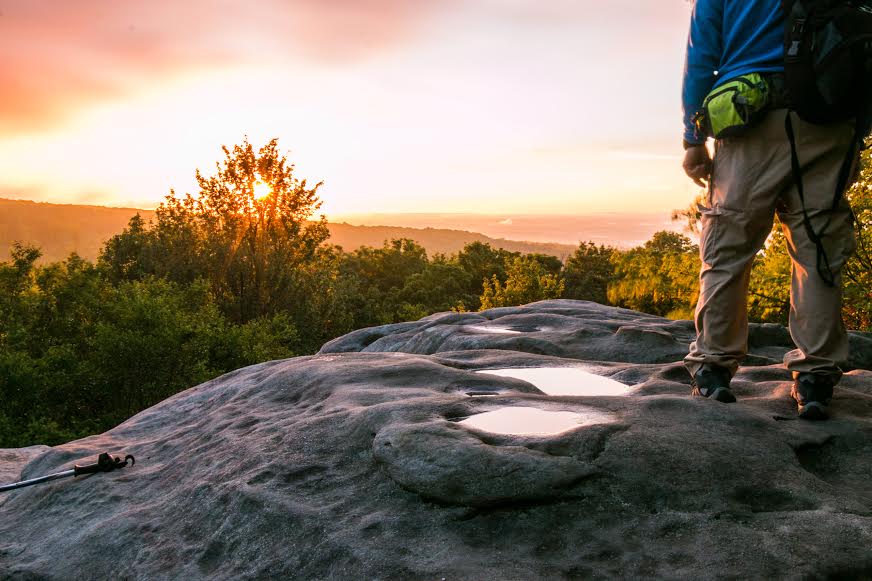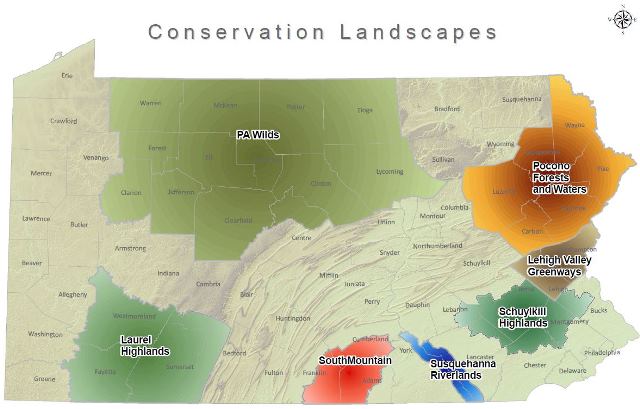
Courtesy: Pennsylvania Environmental Council
Pennsylvania’s Conservation Landscapes program was launched more than a decade ago to connect people to the Commonwealth’s rich heritage of parks and forests. Today with seven designated Conservation Landscapes, it is a model of landscape scale resource management.
While the seven landscapes are unique, all share certain key commonalities. Each is centered around public lands, including local or state parks, state forests, or the long-distance trail systems for which the state is famous. Each encompasses a much larger lived in landscape and actively engages community members and other local partners in resource conservation and sustainable economic development. The goals and work-plans for the seven landscapes reflect regional needs based on community priorities.
For example, many of the Conservation Landscapes in the more developed eastern part of the state, where there is far less public land, work closely with regional land trusts on conservation and acquisition initiatives. In the western part of the state, which has faced long-term de-industrialization, the focus is more on community revitalization through tourism and small business development. All of the landscapes feature projects to encourage resource stewardship and outdoor recreation for the enjoyment of both local residents and visitors. Each landscape has a distinctive story to tell and a wide range of partners.

and Natural Resources
Why has this program endured and thrived through different political administrations and changing local leadership? One reason is the consistent support of a state agency, the Pennsylvania Department of Conservation and Natural Resources. It has made it a priority by both dedicating staff to on the ground leadership roles and providing dependable grant funding. And this is not just any state agency, but one that is rooted in place with a long and distinguished history of public lands management. While many community development initiatives come and go, the Conservation Landscapes link community and public natural resources to the long-term benefit of both.
Another factor is the adaptability of the program leadership to local conditions and new opportunities. This is particularly true for the oldest landscape, the Pennsylvania Wilds, that has established an innovative PA Wilds Center for Entrepreneurship with the mission of integrating conservation and economic development to strengthen and inspire communities. The center has attracted diverse funding and launched a wide range of community enrichment programs. A final indicator of success is that the program is still expanding. A new Conservation Landscape along the Kittatinny Ridge is currently under development and others are under consideration.
A recent report Conservation Landscapes: Models of Successful Collaboration identified a number of the specific factors that have made the program so successful as well as some recommendations for the future. These were:
- Leadership Role of State Government – DCNR has been the driving force in convening and sustaining landscape conservation work. The agency’s role has been essential—as a primary landowner, convener and facilitator, a force for marshalling resources, and a vehicle for aligning policy and spreading lessons learned.
- Consistent Staff and Financial Support – DCNR has underpinned the program with committed staff and annual funding allocations. The durability and success of the program is in many ways attributable to the sustained investment in ensuring that each Conservation Landscape has dedicated staff leadership.
- Holistic Perspective – The program stands out as addressing the social and economic needs of communities as well as natural resource conservation values. This underscores the value in convening a holistic conversation about how communities wish to see their futures unfold—and how the surrounding landscapes are central to those futures.
- Innovative Place-based Projects – Each of the landscapes has been encouraged to develop programs that meet the priorities of local communities and regional conditions. This recognition of the importance of local context has allowed each landscape to forge genuine collaborations focused on the future of the specific region.
- Adaptive Management – All landscapes were found to be meeting their benchmarks including partner consultation, and effective administration of grant programs and funding opportunities. Many landscapes have gone through a re-assessing of their goals and governance. This ability to make needed course adjustment is a sign of strength.
- Connection to Conservation Challenges – The Conservation Landscape approach could play a more significant part in tackling landscape-scale issues like climate change, invasive species, and resilient infrastructure.
- Measuring Success – Evaluation and measurement of impact has been under-attended to across the Conservation Landscape program. Better measurement and communication of outcomes will more concretely document the value and impact of a landscape approach.
“We believe that the landscape-scale approach, now more than 15 years in practice, is well positioned to help Pennsylvania tackle the most challenging problems such as watershed protection, and our changing climate and its impacts on infrastructure, wildlife, and health,” said DCNR Secretary Cindy Adams Dunn. “As we strive to accelerate the pace and scale of conservation efforts, a good understanding of what makes landscape efforts successful is critical.”
Read the full report here: Conservation Landscapes:Models of Successful Collaboration

Pennsylvania Wilds
The Conservation Landscape approach is an exceptional melding of natural resource conservation with collaborative community people centered strategies that has resulted in long term sustainability. With continued investment and some small adjustments, the Conservation Landscape approach is poised to achieve accelerated impact and to tackle challenges such as the changing climate and its impacts on infrastructure, wildlife, and health as well as conserving the landscapes where people live, work and play.



2 Responses
Hi Brenda
Thanks for the good story. Is there a link to the report where you have found this information?
Hi Robin Pinto
Here is a link to the full report Conservation Landscapes: Models of Collaboration
http://www.docs.dcnr.pa.gov/cs/groups/public/documents/document/PA_Conservation_Landscapes_Report2019.pdf
This should have been included in the online article and is now added to the site. Thanks for pointing this out. Glad you liked the story.
Brenda Barrett